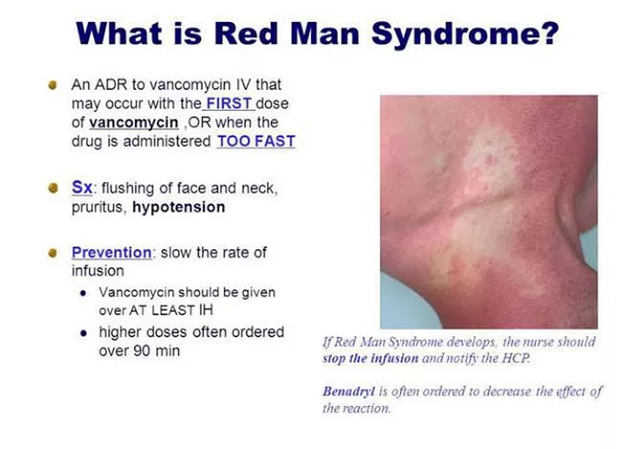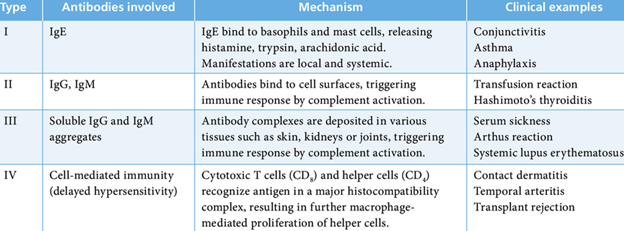The nurse is caring for a patient who is receiving vancomycin (Vancocin). The nurse notes that the patient is experiencing flushing, rash, pruritus, and urticaria. The patient's heart rate is 120 beats per minute, and the blood pressure is 92/57 mm Hg. The nurse understands that these findings are consistent with:
allergic reaction.
rhabdomyolysis.
Stevens-Johnson syndrome.
red man syndrome.
The Correct Answer is D
Allergic reaction: An allergic reaction can manifest in various ways, including rash, itching, and difficulty breathing. However, the specific symptoms described, along with the context of vancomycin administration, point to red man syndrome in this case.
Rhabdomyolysis: Rhabdomyolysis is a condition where damaged muscle tissue breaks down and releases a protein called myoglobin into the bloodstream. This can cause kidney damage, but the symptoms described do not align with rhabdomyolysis.
Stevens-Johnson syndrome: Stevens-Johnson syndrome is a severe skin reaction that can cause skin and mucous membranes to blister, peel, and can be life-threatening. While it can present with rash and other skin symptoms, the symptoms mentioned in the scenario are more characteristic of red man syndrome.
Red man syndrome: As mentioned earlier, red man syndrome is an allergic reaction to vancomycin characterized by flushing, rash, pruritus, and urticaria (hives), along with rapid heart rate and low blood pressure. It is specific to vancomycin and can be prevented or minimized by slowing down the infusion rate and administering antihistamines.

Nursing Test Bank
Naxlex Comprehensive Predictor Exams
Related Questions
Correct Answer is C
Explanation
A. Delayed hypersensitivity reaction: This type of hypersensitivity reaction, also known as Type IV hypersensitivity, involves a delayed response by the immune system and is mediated by T cells. It does not necessarily involve a failure of self-tolerance.
B. Antibody-mediated reaction: This type of hypersensitivity reaction, also known as Type II hypersensitivity, involves antibodies targeting specific antigens on cell surfaces, leading to cell destruction. It doesn't directly indicate a failure of self-tolerance but rather an immune response against specific cells or tissues.
C. Autoimmune reaction: In autoimmune reactions, the immune system fails to recognize certain body tissues or substances as "self," leading to an immune response against the body's own cells or tissues. This results from a breakdown in self-tolerance, where the immune system mistakenly targets its own body.
D. Immediate hypersensitivity reaction: This type of hypersensitivity reaction, also known as Type I hypersensitivity, involves an immediate response by the immune system to an allergen. It includes conditions like allergies and anaphylaxis, where the immune system reacts strongly to substances that are normally harmless. This response does not necessarily indicate a failure of self-tolerance but rather an exaggerated response to specific antigens.
Correct Answer is B
Explanation
A. Type IV Hypersensitivity (Delayed Hypersensitivity Reaction): This type of reaction involves a delayed immune response, typically occurring 24 to 72 hours after exposure to an antigen. It's characterized by the activation of T cells and macrophages, leading to inflammation. This type of hypersensitivity is often associated with conditions like contact dermatitis and some autoimmune diseases.
B. Type III Hypersensitivity (Antibody-Mediated Reaction): Type III hypersensitivity reactions occur when immune complexes, which are composed of antigens and antibodies, deposit in various tissues. This leads to inflammation and tissue damage. Systemic lupus erythematosus (SLE) is an example of a disease associated with Type III hypersensitivity.
C. Type II Hypersensitivity: This type of reaction involves antibodies (IgG or IgM) targeting antigens on the surface of cells. This can lead to cell destruction through various mechanisms, such as complement activation or antibody-dependent cell-mediated cytotoxicity (ADCC). Examples include hemolytic transfusion reactions and autoimmune hemolytic anemia.
D. Type I Hypersensitivity (Immediate Hypersensitivity Reaction): Type I hypersensitivity is characterized by an immediate immune response, typically occurring within minutes of exposure to an allergen. It involves the release of histamines and other mediators from mast cells and basophils, leading to symptoms like hives, respiratory distress, and anaphylaxis. Allergies, like hay fever and food allergies, are examples of Type I hypersensitivity reactions.

Whether you are a student looking to ace your exams or a practicing nurse seeking to enhance your expertise , our nursing education contents will empower you with the confidence and competence to make a difference in the lives of patients and become a respected leader in the healthcare field.
Visit Naxlex, invest in your future and unlock endless possibilities with our unparalleled nursing education contents today
Report Wrong Answer on the Current Question
Do you disagree with the answer? If yes, what is your expected answer? Explain.
Kindly be descriptive with the issue you are facing.
